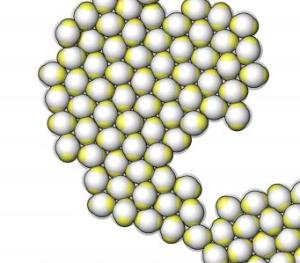Feb 5 2014
Tuning the material structure at the nanoscale level can be really hard to achieve – but what if we had small particles, which assemble all by themselves, creating the required structure? At the Vienna University of Technology (TU Wien), the phenomenon of self-assembly is being investigated by studying inhomogeneously charged particles. Depending on different parameters, they can form gel-like or crystal-like structures. This kind of self-assembly holds great promise for nanotechnology.
 Ordered, crystal-like structures are shown. (credit: TU Vienna)
Ordered, crystal-like structures are shown. (credit: TU Vienna)
Micro Particles with Specially Structured Surfaces
Emanuela Bianchi is a scientist in Prof. Gerhard Kahls research group at the Institute for Theoretical Physics of the Vienna University of Technology. In her computer simulations, she reproduces the bahavior of particles which are no bigger than a few micrometers – comparable to viruses or small bacteria. She is especially interested in nanoparticles with a complicated surface, consisting of different kinds of patches distinguished by different physical properties.
Recent work (funded via an Elise Richter Fellowhip by the FWF) has focused on particles with inhomogeneously charged surface regions: The majority of the particle carries negative electric charge, but the polar regions on the top and at the bottom of the particle are positively charged. "Due to the fact that like charges repel while opposite charges attract each other", says Emanuela Bianchi, "our particles tend to align in such a way that the pole of one particle points towards the equator of the other." But when many of these particles interact, things get more complicated.
Computer simulations have now been able to show how these particles behave when they are trapped between two planes so that they have to align in quasi two dimensional structures. The results showed that there are different possible configurations: Sometimes the particles are tightly packed in a simple hexagonal structure, which is well known from crystals. Sometimes, less ordered gel-like structures emerge, with interconnected rings of five or six particles.
"With our model, we can find out which parameters determine the emerging structure", says Emanuela Bianchi. The size of the positively charged polar patches plays an especially important role. Spheres on which the border between negative and positive charge is at 45 degrees latitude create much more ordered structures than particles on which this border is closer at the pole, at 60 degrees. The result can also be influenced by tuning the electrical charge of the floor plate on which the particles rest – a parameter which is very easy to control in an experiment. Such a parameter controls the size of the aggregates and can even be responsible for a complete suppression of the particle aggregation.
Materials with Taylor Made Properties
Understanding the self-assembly of microparticles opens the door to designing particles which automatically form taylor-made structures. Depending on the microscopic alignment of the particles, they create surface types with different densities and different responses to external stimuli (e.g. elcetromagnetic fields). This means that self-assembled structures could for instance be used to create filters with tunable porosity. "Especially for biomedical applications, this could have many possible applications", says Emanuela Bianchi.
The results of the research project have been published in the journal "ACS Nano".
Source: http://www.tuwien.ac.at